NCERT Solutions for Class 8 Social Science History Chapter 11 The Making of the National Movement 1870s – 1947
These Solutions are part of NCERT Solutions for Class 8 Social Science. Here we have given. NCERT Solutions for Class 8 Social Science History Chapter 11 The Making of the National Movement 1870s – 1947
Question 1.Why were people dissatisfied with British rule in the 1870s and 1880s?
Answer:
People were dissatisfied with British rule in the 1870s and 1880s due to the following reasons:
- The British passed the Arms Act in 1878 which disallowed Indians from possessing arms.
- In the same year, they passed the Vernacular Press Act. This Act snatched freedom of speech and expression. It allowed the government to confiscate the assets of newspapers including their printing presses if the newspapers published anything that was critical of the government.
- In 1883, the Ilbert Bill was introduced. The bill provided for the trial of British or European persons by Indians and sought equality between British and Indian judges in the country. But the white opposition forced the government to withdraw the bill.
Question 2.
Who did the Indian National Congress wish to speak for?
Answer:
- The need for an all-India organisation of educated Indians had been felt since 1880.
- The Ilbert Bill controversy deepened this desire.
- The Indian National Congress was established when 72 delegates from all over the country met at Bombay in December 1885 to speak for the people of India to the government.
Question 3.
What economic impact did the First World War have on India?
Answer:
The First World War led to a huge rise in the defence expenditure of the Government of India. The government in turn increased taxes on individual incomes and business profits. Increased military expenditure and the demands for war supplies led to the sharp rise in prices which badly affected the common mass. They found it difficult to fulfil even their essential needs.
But the business groups earned huge profits from the war. The war created a demand for industrial goods like jute bags, cloth, rails, and caused a decline of imports from other countries into India. As a result Indian industries expanded during the war.
Question 4.
What did the Muslim League resolution of 1940 ask for?
Answer:
In 1940 the Muslim League demanded “Independent States” for Muslims in the north-western and eastern areas of the country.
1. The resolution did not mention partition or Pakistan.
2. From the late 1930s, the League began viewing the Muslims as a separate “nation” from the Hindus.
3. Besides, the provincial elections of 1937 convinced the League that Muslims were a minority, and they would always have to play second fiddle in any democratic structure.
- It feared that the Muslims may even go unrepresented.
- The Congress rejected the League’s desire to form a joint Congress-League’s government in the United Province (now Uttar Pradesh) in 1937.
- This also annoyed the League.
Question 5.
Who were the Moderates? How did they propose to struggle against British rule?
Answer:
The Moderates were against taking extreme actions. They had deep faith in the good intention of the government. They were of the opinion that slowly and steadily they would make the British go to their own land. The Moderate leaders developed public awareness about the unjust nature of British rule. They published newspapers, wrote articles and showed how British rule was leading to the economic ruin of the country. They criticised British rule in their speeches and sent representatives to different parts of the country to mobilise public opinion. They believed that the British had respect for the ideals of freedom and justice and therefore they would definitely accept all the just demands of the people of India. Their main task was to acknowledge the British government with these demands.
Question 6.
How was the politics of the Radicals within the Congress different from that of the Moderates?
Answer:
By the 1890s a large number of Indians began to raise questions on the political style of the Congress.
- In Bengal, Maharashtra and Punjab, leaders like Bipin Chandra Pal, Bal Gangadhar Tilak and Lala Lajpat Rai began to explore more radical objectives and methods. They were popularly called: Lal-Bal-Pal.
- They criticised the Moderates for their “politics of prayers”.
- They emphasised the importance of self-reliance and constructive work.
- They argued that people must rely on their own strength, not on the “good” intentions of the government.
- They also said that people must fight for
- Tilak raised the slogan, “Freedom is my birthright and I shall have it!”
Question 7.
Discuss the various forms that the Non-Cooperation Movement took in different parts of India. How did the people understand Gandhiji?
Answer:
The Non-Cooperation Movement spread far and wide. It took various forms in different parts of the country:
- In Kheda, Gujarat, Patidar peasants were worried about the high land revenue demand of the British. Hence, they organised non-violent campaigns against it.
- In coastal Andhra and interior Tamil Nadu, liquor shops were picketed.
- In the Guntur district of Andhra Pradesh, tribals and poor peasants started several forest satyagrahas’, sometimes sending their cattle into forests without paying grazing tax. They were very much fed up with the restrictions imposed on them by the British regarding the use of forest resources. They wanted the abolition of the forest regulations.
- In Sind, now in Pakistan, Muslim traders and peasants were very enthusiastic about the Khilafat call. In Bengal too, the Khilafat-Non- Cooperation alliance gave enormous communal unity and strength to the national movement.
- In Punjab, the Akali agitation of the Sikhs sought to drive out corrupt mahants, supported by the British, from the gurudwaras. This movement got closely identified with the Non-Cooperation Movement.
- In Assam, tea garden labourers left the British-owned plantations and became the followers of Gandhiji. People viewed Gandhiji as a messiah, as someone who could help them overcome their misery and poverty.
Question 8.
Why did Gandhiji choose to break the salt law?
Answer:
Gandhiji’s Choice to Break Salt Law
- In 1930, Gandhiji led a march to break the salt law.
- According to this law, the state had a monopoly on the manufacture and sale of salt.
- Mahatma Gandhi along with other nationalists reasoned that it was sinful to tax salt since it is such an essential item of our food.
Question 9.
Discuss those developments of the 1937-47 period that led to the creation of Pakistan.
Answer:
From the late – 1930s, the Muslim League began viewing the Muslims as a separate-nation from the Hindus. This nation might have developed because of the history of tension between some Hindu and Muslim groups in the 1920s and 1930s. The provincial elections of 1937 also might have convinced the League the Muslims were a minority and they would always have to play second fiddle, in any democratic structure.
Meanwhile, Congress rejected the League’s desire to form a joint Congress-League government jn the United Provinces in 1937. This annoyed the League. In 1940, the League finally moved a resolution demanding ‘Independent States’ for Muslims in the north¬western and eastern areas of the country. The resolution did not mention partition or Pakistan.
In 1945, the British opened negotiations between Congress, the League, and themselves for the independence of India. The talks could not succeed because the League saw itself as the sole spokesperson of India’s Muslims. The Congress proved
this claim baseless because several Muslims still supported it.
In the provincial electrons in 1946 the League got grand success in the seats reserved for Muslims. Hence it persisted its demand for Pakistan. In March 1946, the Cabinet Mission came to Delhi to examine this demand and to suggest a suitable political framework for a free India. This Mission suggested that India should remain united and constitute itself as a loose confederation with some autonomy for Muslim-majority areas. Neither the Congress nor the Muslim League agreed to it. The failure of the Cabinet Mission made partition inevitable. Ultimately in 1947 partition took place with the birth of a new country, i.e. Pakistan.
Question 10.
Find out how the national movement was organised in your city, district, area or state. Who participated in it and who led it? What did the movement in your area achieve?
Answer:
(Students to do it as per their area)
Organisation of National Movement in our city:
Hints:
- Visit of Gandhiji.
- Formation of Action Committees.
- Meetings and awareness of different events at the national level.
- Prabhat Pheries and Rallies.
- Protest march to district headquarters.
- Mass arrests.
- Hanging of the freedom fighters.
- Award after getting independence.
Question 11.
Find out more about the life and work of any two participants or leaders of the national movement and write a short essay about them. You may choose a person not mentioned in this chapter.
Answer:
(a) Dr. Rajendra Prasad
Dr. Rajendra Prasad started his political career as a social worker. He came under the influence of Mahatma Gandhi since the Champaran Satyagraha of 1918. He came in the light when he took a sincere part in Champaran Satyagraha. The Jallianwala Bagh atrocities deeply perturbed him. He was sent to jail many times. He struggled hard for the independence of the country. He was the most uncontroversial figure in Indian politics. Under his presidentship, the country made all-round progress.
(b) Jaiprakash Narayan
Jaiprakash Narayan fully dedicated his life to the welfare of the country. In 1934, be plunged into the struggle for freedom. In the same, he became the Secretary of the Socialist Party. Jawaharlal Nehru offered him the membership of the Congress Working Committee in 1946 but he rejected the offer. On Nehru’s second request, he joined the Congress Committee with Ram Manohar Lohia but both of them left it soon. Shri Jaiprakash Narayan became the General Secretary of the Socialist Party which got itself separated from Congress. He took great interest in the political development of the country. He is known for his selfless service for the nation.
Objective Type Questions
1. Match the following: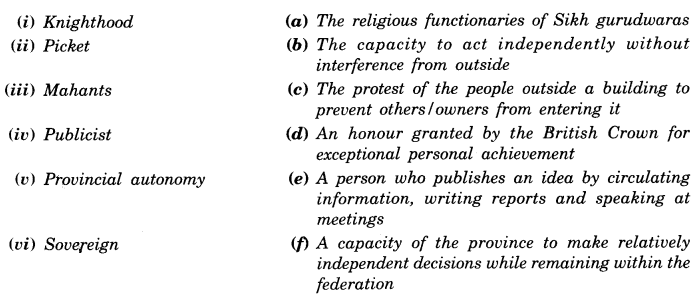 Answer:
Answer:
(i) d
(ii) c
(iii) a
(iv) e
(v) f
(vi) b
2. State whether True or False:
- People were satisfied with British rule in the 1870s and 1880s. False
- The Arms Act was passed in 1875. False
- O. Hume was a Chinese educationist. False
- Muslim League demanded “Independent States” for Muslims in 1940. True
- The Congress in the first twenty years of its formation was “moderate”. True
- In 1930, Gandhiji led a march to break the salt law. True
- The leaders of the Khilafat agitation were Mohammad Ali and Shaukat Ali. True
3. Fill in the blanks:
- The Arms Act disallowed Indians from having arms.
- Gandhiji and his followers marched from Sabarmati to Dandi.
- 16 August 1946 was announced as Direct Action Day by the Muslim League.
- C. Rajagopalachari is popularly known as Rajaji.
Multiple Choice Questions
Choose the correct answer:
1. Marathi newspaper ‘Kesari’ was edited by
(a) Lala Lajpat Rai
(b) Balgangadhar Tilak
(c) Chitta Ranjan Das
(d) Sarojini Naidu
2. Lala Lajpat Rai was a nationalist from
(a) Bengal
(b) Bihar
(c) Punjab
(d) Haryana
3. Which of the following movement is associated with Chitta Ranjan Das?
(a) Quit India Movement
(b) The Salt March
(c) Non-Cooperation Movement
(d) None of these
4. The founder of Khudai Khidmatgars was
(a) Mohammad Ali
(b) Shaukat Ali
(c) Bashah Khan
(d) None of these
5. Who established the Natal Congress?
(a) Jawaharlal Nehru
(b) Mahatma Gandhi
(c) Balgahgadhar Tilak
(d) Lala Lajpat Rai
6. Bengal was divided by the British in the year
(a) 1900
(b) 1910
(c) 1905
(d) 1920
7. Hindustan Socialist Republic Association was related with the nationalist
(a) Lala Lajpat Rai
(b) Balgangadhar Tilak
(c) Bhagat Singh
(d) None of these
8. The Vernacular Press Act was enacted in
(a) 1840
(b) 1857
(c) 1878
(d) 1890
9. Ilbert Bill was introduced in
(a) 1860
(b) 1878
(c) 1883
(d) 1890
10. Naoroji was……… settled in London.
(a) a businessman and publicist
(b) an artist
(c) an educationist
(d) none of these
11. Second World War ended in
(a) 1910
(b) 1920
(c) 1945
(d) 1920
12. The fight for Purna Swaraj was fought under the presidentship of
(a) Mahatma Gandhi
(b) Jawaharlal Nehru
(c) C. Rajagopalachari
(d) Sardar Vallabhbhai Patel
13. Who was the first Indian Governor-General of free India?
(a) Mahatma Gandhi
(b) Jawaharlal Nehru
(c) C. Rajagopalachari
(d) Sardar Vallabhbhai Patel
Class 8 History Chapter 11 The Making of the National Movement Exercise Questions
Question 1.
Choose the correct option.
(i) The book Poverty and Un-British Rule in India is authored by
(a) Mahatma Gandhi
(b) Dadabhai Naoroji
(c) Jawaharlal Nehru
(d) Sarojini Naidu
(ii) The Marathi newspaper was edited by
(a) Balgangadhar Tilak
(b) Bepin Chandra Pal
(c) Lala Lajpat Rai
(d) Dadabhai Naoroji
(iii) The slogan ‘Freedom is my birthright and I shall have it’ was raised by
(a) Bepin Chandra Pal
(b) Sarojini Naidu
(c) Lala Lajpat Rai
(d) Balgangadhar Tilak
(iv) The Indian who renounced his knighthood after the Jallianwala Bagh massacre
(a) Subhas Chandra Bose
(b) Rabindranath Tagore
(c) Abanindranath Tagore
(d) Bhagat Singh
(v) The first Indian woman to become President of the Indian National Congress was
(a) Sarojini Naidu
(b) Kamla Nehru
(c) Begum Rokeya Shakhawat Hossain
(d) Kasturba Gandhi
(vi) Free India’s first Indian Governor- General was
(a) Lala Lajpat Rai
(b) Motilal Nehru
(c) C. Rajagopalachari
(d) Sardar Ballabbhai Patel
Answer:
(i) (b), (ii) (a), (iii) (d), (iv) (b), (v) (a), (vi) (c).
Question 2.
Fill in the blanks with appropriate words to complete each sentence.
- The Indian National Congress was established when ……………. delegates from all over the country met at ……………… in December 1885.
- The Moderate leaders did not believe in ………….. actions.
- The All India Muslim League was formed by a group of Muslim …………. and …………….
- The Rowlatt Act curbed ………… rights such as the freedom of expression and strengthened …………… powers.
- Mahatma Gandhi abruptly called off the ……………… Movement when it took violent turn.
- The Congress resolved to fight for Puma Swaraj in 1929 under the presidentship of ……………….
- The Quit India Movement started in August …………..
Answer:
- 72, Bombay
- extreme
- landlords, nawabs
- fundamental, police
- Non-Cooperation
- Jawaharlal Nehru
- 1942.
Question 3.
State whether each of the following statements is True or False.
- Subhas Chandra Bose was a moderate nationalist.
- The Simon Commission had two Indian representatives.
- The Jallianwala Bagh massacre occurred in Amritsar on Baishakhi day.
- The Swadeshi Movement started after the partition of Bengal.
- MaulanaAzad became the major spokes-person for the demand for Pakistan.
- Khan Abdul Ghaffar Khan, also known as Badshah Khan, founded the Khudai Khidmatgars.
Answer:
- False
- False
- True
- True
- False
- True
Question 4.
Match the items given in Column A correctly with those given in Column B.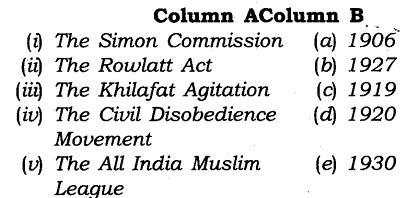
Answer:
(i) (b), (ii) (c), (iii) (d), (iv) (e), (v) (a).
Class 8 History Chapter 11 The Making of the National Movement Very Short Answer Type Questions
Question 1.
What is the literal meaning of sarvajanik?
Answer:
The literal meaning of sarvajanik is ‘of or for all the people’. It is made
of two words – sarva = all + janik = of the people.
Question 2.
Who was A.O. Hume? What role did he play in the history of India?
Answer:
A.O. Hume was a retired British official. He played an important role in bringing Indians from the various regions together.
Question 3.
Who was the Viceroy of India at the time of the partition of Bengal
Answer:
At that time Lord Curzon was the Viceroy of India.
Question 4.
What was the Swadeshi Movement known as in deltaic Andhra?
Answer:
In deltaic Andhra the Swadeshi Movement was known as the Vandemataram Movement.
Question 5.
Name the three leading members of the Radical group.
Answer:
Bepin Chandra Pal, Balgangadhar Tilak and Lala Lajpat Rai.
Question 6.
Why did Mahatma Gandhi along with other Indians establish the Natal Congress in South Africa?
Answer:
He did so in order to fight against racial discrimination in South Africa.
Question 7.
Name three places where Gandhiji started local movements.
Answer:
Champaran, Kheda and Ahmedabad.
Question 8.
Why did Rabindranath Tagore renounce his knighthood?
Answer:
Rabindranath Tagore renounced his knighthood to express the pain and anger of the country following the Jallianwala Bagh atrocities.
Question 9.
Who were the leaders of the Khilafat agitation?
Answer:
The leaders of the Khilafat agitation were Mohammad Ali and Shaukat Ali.
Question 10.
What does ‘Punjab wrongs’ refer to?
Answer:
It refers to Jallianwalla Bagh massarcre that occurred on 13 April, 1919 in Amritsar on Baishakhi day.
Question 11.
Who was Chitta Ranjan Das?
Answer:
He was a lawyer from East Bengal and was active in the Non-Cooperation Movement.
Question 12.
What does RSS stand for?
Answer:
RSS stands for Rashtriya Swayamsevak Sangh.
Question 13.
Who was Bhagat Singh? What slogan did he raise?
Answer:
Bhagat Singh was a revolutionary nationalist. His slogan was—Inquilab Zindabad.
Question 14.
What does HSRA stand for?
Answer:
HSRA stands for Hindustan Socialist Republican Association.
Question 15.
Why did Mahatma Gandhi decide to break the Salt Law?
Answer:
Mahatma Gandhi decided to break the Salt Law because it established the monopoly of the state on the manufacture and sale of salt.
Question 16.
On what condition-were the Congress leaders ready to support the British war effort at the time of the Second World War?
Answer:
The Congress leaders were ready to support the British war effort on condition that they would declare India’s independence after the war.
Question 17.
Did the British accept their condition?
Answer:
No, the British did not accept their condition.
Question 18.
Who raised the slogan ‘do or die’?
Answer:
Mahatma Gandhi raised this slogan.
Question 19.
Why did the Muslim League announced 16 August 1946 as ‘Direct Action Day’?
Answer:
It announced 16 August, 1946 as ‘Direct Action Day’ in support of its demand for Pakistan.
Class 8 History Chapter 11 The Making of the National Movement Short Answer Type Questions
Question 1.
What were the demands of the Congress in its early years?
Answer:
In its early years the Congress was moderate in its objectives and methods. It made several demands; which are given below:
- The Congress demanded a greater voice for Indians in the government and in administration.
- It demanded that Indians be placed in high positions in the government. For this purpose it called for Civil Service examinations to be held in India as well, not just in London.
- The Congress demanded for the separation of the judiciary from the executive.
- The repeal of the Arms Act and the freedom of speech and expression was also a major demand of the Congress.
- It also demanded reduction of revenue, cut in military expenditure and more funds for irrigation.
Question 2.
What caused the partition of Bengal in 1905?
Or
Under what pretext, did the British divide Bengal?
Answer:
At the time of partition Bengal was the biggest province of British India which comprised Bihar and parts of Orissa. The British argued for dividing Bengal for reasons of administrative convenience. But it was a totally false argument. In fact, the partition of Bengal was closely tied to the interests of British officials and businessmen. The British also wanted to curtail the influence of Bengali politicians and split the Bengali people. It was therefore, instead of removing the non-Bengali areas from the province, they separated East Bengal and merged it with Assam.
Question 3.
What were the consequences of the partition of Bengal?
Answer:
(a) The partition of Bengal enraged people all over the country. Both the Moderates and the Radicals in the Congress opposed this action of the British.
(b) Public meetings and demonstrations began to be organised. Novel methods of mass protest were also developed. They struggled against the partition of Bengal came to be known as Swadeshi Movement. In Bengal this movement was the strongest. In other regions .such as in deltaic Andhra the movement was called the Vandemataram Movements.
Question 4.
What was the Khilafat agitation?
Answer:
In the year 1920 the British imposed a harsh treaty on the Turkish Sultan, known as Khalifa. It enraged people. Indian Muslims wanted that the Khalifa be allowed to retain control over Muslim sacred places in the erstwhile Ottoman empire. The leaders of the Khilafat agitation Mohammad Ali and Shaukat Ali, now wished to start a full-fledged Non-Cooperation Movement. They got support from Mahatma Gandhi who urged the Congress to campaign against “Punjab wrongs’, the Khilafat wrong and demand swaraj.
Question 5.
How did people participate in the Non-Cooperation Movement during 1921-22?
Answer:
- During these years, thousands of students left government controlled schools and colleges.
- Many lawyers such as Motilal Nehru, C.R. Das, C. Rajagopalachari and Asaf Ali gave up their practices.
- British titles were surrendered and legislatures boycotted.
- People lit public bonfires of foreign cloth.
Question 6.
Why was the Simon Commission sent to India? Why did Indians boycott it?
Answer:
The British government in England sent a Commission headed by Lord Simon in the year 1927 to decide India’s political future. As the Commission had no Indian representative, it was boycotted by all political groups. When the Commission arrived it met with demonstrations with banners saying ‘Simon Go Back’.
Question 7.
What role did Ambabai play in the Indian freedom struggle?
Answer:
Ambabai came from Karnataka. She had been married at age twelve and was widowed at sixteen. Afterwards she began participating in the Indian freedom struggle. She picketed foreign cloth and liquor shops in Udipi. She was arrested, served a sentence and was rearrested. Between prison terms she made powerful speeches, taught spinning and organised prabhat pheris.
Question 8.
Write a brief paragraph on Maulana Azad.
Answer:
Maulana Azad was a great leader of the Indian freedom struggle. He was born in Mecca to a Bengali Father and an Arab Mother. He was well- versed in several languages. He was a scholar of Islam and an exponent of the notion of wahadat-i-deen, the essential oneness of all religions. He was an active participant in the movement launched by Mahatma Gandhi. He was a great advocate of Hindu-Muslim unity. He never approved Jinnah’s two-nation theory. He wanted a country in which Hindus and Muslims lived in perfect harmony.
Question 9.
Write a brief note on Khan Abdul Ghajfar Khan.
Answer:
Khan Abdul Ghaffar Khan was the Pashtun leader from the North-West Frontier Province. He was popularly known as Badshah Khan. He founded the Khudai Khidmatgars, which was a powerful non-violent movement among the Pattans of his province. He was a staunch supporter of Hindu-Muslim unity and was strongly opposed to the partition of India. He criticised his Congress colleagues for agreeing to the division of India in 1947.
Class 8 History Chapter 11 The Making of the National Movement Long Answer Type Questions
Question 1.
What was the Rowlatt Act? Give an account of the Rowlatt Satyagraha.
Answer:
The British passed the Rowlatt Act in the year 1919. The Act curbed fundamental rights such as the freedom of expression and strengthened police powers. The Act was very repressive and therefore it enraged Indians. Prominent leaders of the freedom struggles such as Mahatma Gandhi, Mohammad Ali Jinnah, etc. felt that the government had no right to restrict the basic freedoms of people. They viewed the Act as devilish and tyrannical. Gandhiji decided to oppose this Act. He asked people of India to observe 6 April 1919 as a day of non-violent opposition to the Act, as a day of “humiliation and prayer’ and hartal. He organised Satyagraha Sabhas to launch the movement.
The Rowlatt Satyagraha spread far and wide. It became the first All- India struggle against the British government. In April 1919 several demonstrations and hartals took place in the country. But the government suppressed them taking brutal measures. The Jallianwala Bagh massacre was the climax of its brutality. This incident took place on 13 April in Amritsar on Baishakhi day. Thousands of people had gathered in the Jallianwala Bagh to celebrate the occasion. General Dyre opened fire on them all of a sudden.
Both Hindu and Muslim unitedly criticised the British action.
Question 2.
Describe Gandhi’s march to Dandi.
Answer:
Gandhiji felt that Purna Swaraj would not come on its own. It had to be fought for. He was very much worried about government’s Salt Law. In 1930, he decided to break this law.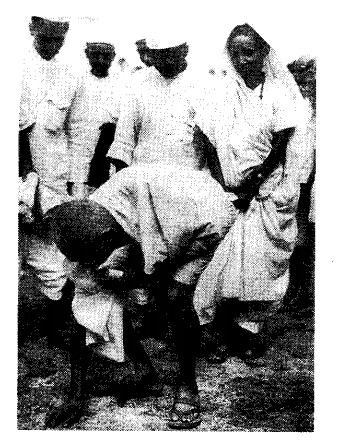
According to the law, the state had a monopoly on the manufacture and sale of salt. Mahatma Gandhi and other prominent leaders of the freedom struggle thought that it was sinful to tax salt because it is an essential item of our food. Both the rich and the poor needed it equally. Gandhiji felt that his Salt March would become popular and would represent the genral desire of freedom to a specific grievance shared by all. On 6 April, 1930, Gandhiji alongwith his followers marched for over 240 miles from Sabarmati to the coastal town of Dandi. Here, they broke the government law by gathering natural salt found on the seashore, and boiling sea water to produce salt.
A large number of people including women participated in this historic march. The government tried to crush the movement through brutal action against peaceful satyagrahis. Thousands were arrested and sent to jail. But the movement played a significant role in achieving freedom of India.
Question 3.
Under what circumstances did Gandhiji initiate the Quit India Movement?
Answer:
In September 1939, the Second World War broke out. The. British government in India needed help from the Indian leaders. The leaders were ready to support the British war effort. But in return they wanted that India be granted independence after the war. The British refused to accept the demand. This enraged the Congress ministries. They all resigned to show their protest.
Mahatma Gandhi was deeply perturbed. He now decided to initiate a new phase of movement against the British rule in the middle of the Second World War. This movement came to be known as the Quit India Movement. Gandhiji thought that the British must Quit India without further delay. He raised the slogan ‘do or die’ which spread among the common mass very soon. But at the same time he warned the people not to be violent in any condition.
The British took repressive measures. Gandhiji along with other leaders were sent to jail immediately. But this did not prevent the movement from spreading. It specially attracted peasants and the youth who gave up their studies to join the movement. Communications and symbols of state authority were attacked all over the country. In several areas people set up their own governments. The British tried to repress these developments severely. About 90,000 people were arrested and wound 1,000 killed in police firing. But the movement did not go in vain. It brought freedom very close.
Class 8 History Chapter 11 The Making of the National Movement Source-Based Questions
Question 1.
Read the following extract (Source 2) taken from the NCERT textbook and answer the questions that follow:
In pursuit of gold
This is what a Moderate leader, Dinshaw Wacha, wrote to Naoroji in 1887:
Pherozeshah is nowadays too busy with his personal work … They are already rich enough … Mr. Telang too remains busy. I wonder how if all remain busy in the pursuit of gold can the progress of the country be advanced?
Questions:
(i) Who was Dinshaw Wacha?
(ii) Whom did he write to?
(iii) What did he write in the letter?
Answers:
(i) Dinshaw Wacha was a Moderate leader of the Congress.
(ii) He wrote to Naoroji.
(iii) He wrote in the letter that if people like Pherozeshah and Telang remained busy in making wealth, then how would the country achieve its independence?
Class 8 History Chapter 11 The Making of the National Movement Picture-Based Questions
Question 1.
Observe the pictures taken from NCERT textbook subsequently and answer the questions that follow: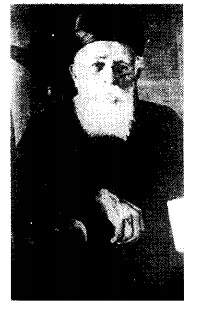
Questions:
(i) Who is he?
(ii) Which book did he write?
(iii) What was the book about?
Answers:
(i) He is Dadabhai Naoroji.
(ii) He wrote a book named Poverty and Un-British Rule in India.
(iii) The book offered a scathing criticism of the economic impact of British rule.
Question 2.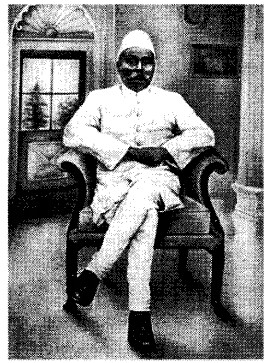
Questions:
(i) Identify the above personality.
(ii) Which state did he belong to?
(iii) Write two sentences about him.
Answers:
(i) Lala Lajpat Rai.
(ii) He belonged to Punjab.
(iii) He was one of the leading members of the Radical group. He criticised the moderates for their politics of petitions:
Question 3.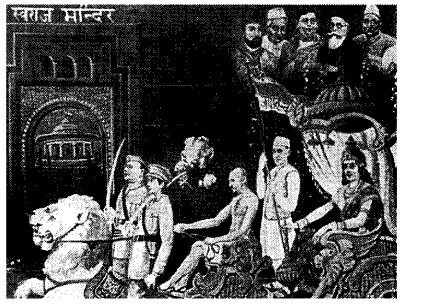
Questions:
(i) Describe the image given above.
(ii) Who is holding the tricolour?
Answers:
(i) In the above image Mahatma Gandhi has been shown as a divine being occupying a place within the pantheon of Indian gods. Here he is driving Krishna’s chariot, guiding other nationalist leaders in the battle against the British.
(ii) Pandit Jawaharlal Nehru is holding the tricolour.